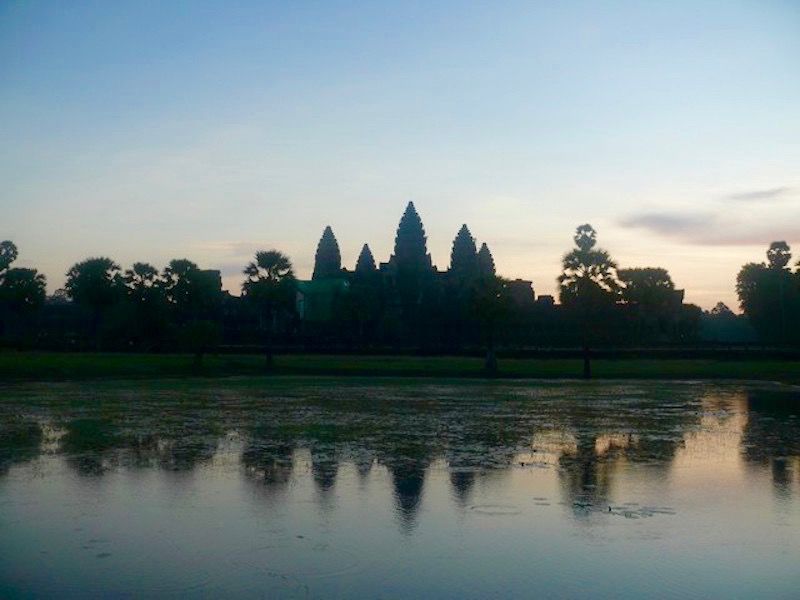Angkor Temple Guide: #3 Angkor Wat
Today it is the turn of the big one. I am posting these in alphabetical order otherwise I would have built up to this one, to post it last. It is the one, the only, Angkor Wat.

The History of Angkor Wat
Angkor Wat is, quite simply, the largest religious temple site on Earth. It stands on 402 acres 85.5km (3.4 miles) to the north of Siem Reap. That it also happens to be one of the finest is beyond argument. This is the premier destination for millions who travel to Cambodia every year, and it is not difficult to see the attraction. This landmark Buddhist temple is one of the biggest tourist attractions anywhere in the world. It is the symbol of Cambodia, and proudly adorns their national flag.
It was constructed in the early 12th century by King Suryavarman II, originally as a Hindu temple dedicated to the God Vishnu. Later converting to a Buddhist monument, it has remained an active temple since its foundation, the only one of the Angkor Temples to do so.
.jpg)
Angkor Wat dominates the landscape as you stand before it, approached by a long causeway over a moat that is 190m (620ft) wide. The outer wall is 4.5m (15ft) high and runs for 3.6km (2.2miles). This encloses an area of 82 hectares (203 acres), most of which is covered in forest. The main body of the temple consists of three galleries, each taller than the next. The central tower is 65m (213ft) high. It is the tallest building in the Siem Reap area; no other building is allowed to be built that is taller. Nobody looks down on Angkor Wat!
At the Heart of Angkor Wat
The temple is a remarkably complex representation of Mount Meru, purportedly the home of the gods. At its heart is an arrangement of five towers, called a quincunx. This symbolises the five peaks of Mount Meru. Beyond this, the walls and moat symbolise the surrounding mountain range and the ocean.

The extent of the bas relief work here is quite remarkable. Every inch appears to have been carved in intricate detail. The roofs of the galleries are decorated with carvings of the body of Garudas, a snake-like creature with the head of a lion. The inner walls of the outer gallery are decorated with a series of large-scale scenes that depict episodes from the great Hindu epics; the Ramayana and the Mahabharata. The world renowned British archaeologist, Charles Higham, called these "the greatest known linear arrangement of stone carving”.
The extent of the carvings boggles the mind. To think that this was all completed over a period of just 32 years is astonishing. It is thought that 10,000 stonemasons carried out the work. Yet it looks as though it was almost done by one person. The gallery wall alone contains almost 1,000 square metres of bas reliefs.
.jpg)
A Huge Construction Undertaking Even by Today’s Standards
Angkor Wat was constructed by using carved blocks of solid stone. These were polished as smooth as marble before being laid together using no mortar. In places it is impossible to see the joins. They are held together using mortise and tenon joints, whilst in other cases dovetails and gravity were employed. There are somewhere between 6 and 10 million of these blocks employed here. The average weight is 1.5 tons. They came from Mount Kulen 40km (25miles) to the northwest of Angkor.
In 1992 it was inscribed onto the UNESCO list of World Heritage Sites. In 1993 it received just 7,650 visitors. Nowadays some two million people per year enjoy tours here. In 2012 at the ASEAN Tourism Forum, it was agreed that the Indonesian temple site of Borobudur and Angkor Wat would become sister sites, and the provinces sister provinces.
.jpg)
Angkor Wat is the top place to visit in Cambodia and for many many miles around. It is a must-see on any itinerary.
Top Tips
Avoid visiting any of the temple sites in the middle of the day. The heat in Cambodia is extremely fierce. Strolling around these sites may not seem arduous, but in 40+ºC it can be very taxing.
Always remember that first and foremost this is a religious site. Cover arms and legs, speak quietly and behave modestly and appropriately.
Previously published:
https://steemit.com/travel/@inseasia/angkor-temple-guide-1-ak-yom
https://steemit.com/travel/@inseasia/angkor-temple-2-angkor-thom
I have been developing the InSeAsia website for three years. It genuinely is a labour of love. I have lived in Southeast Asia for 9 years and have no plans to ever leave.
Please up vote, comment and re-steem, and come and check us out
Website: https://www.inseasia.com
Facebook: https://www.facebook.com/InSeAsia/
Instagram: https://www.instagram.com/inseasia/
My Vietnam trip included an add on to Angor Wat. I regret we didn't have time to do it. Followed as well.
Thanks my friend. I have been many times and I never tire of it. I am not at all religious but it moves me every time I go. Astonishing beautiful and magical place.